Hydrological Response of Tropical Catchments to Climate Change as Modeled by the GR2M Model: A Case Study in Costa Rica
Abstract
1. Introduction
2. Materials and Methods
2.1. Research Methodology
2.2. Research Methodology
2.3. Observational and Hydrological Datasets
2.4. Climate Change Datasets
2.5. Bias Correction of Climate Change Datasets
2.6. The GR2M Hydrological Model
2.7. Parameter Optimization and Performance Assessment
2.8. Future Climate Change Scenarios
3. Results and Discussion
3.1. GR2M Performance Evaluation
3.2. Historical Simulation of Precipitation and Temperature
3.3. Future Changes in Precipitation and Temperature
3.4. Future Hydrological Response
4. Conclusions
Author Contributions
Funding
Institutional Review Board Statement
Informed Consent Statement
Data Availability Statement
Acknowledgments
Conflicts of Interest
References
- Huntington, T.G. Evidence for intensification of the global water cycle: Review and synthesis. J. Hydrol. 2006, 319, 83–95. [Google Scholar] [CrossRef]
- Thompson, J.R.; Iravani, H.; Clilverd, H.M.; Sayer, C.D.; Heppell, C.M.; Axmacher, J.C. Simulation of the Hydrological Impacts of Climate Change on a Restored Floodplain. Hydrol. Earth Syst. Sci. 2017, 62, 2482–2510. [Google Scholar] [CrossRef]
- Donevska, K.; Panov, A. Climate Change Impact on Water Supply Demands: Case Study of the City of Skopje. Water Supply. 2019, 7, 2172–2178. [Google Scholar] [CrossRef]
- Olsson, J.; Arheimer, B.; Borris, M.; Donnelly, C.; Foster, K.; Nikulin, G.; Persson, M.; Perttu, A.-M.; Uvo, C.; Viklander, M.; et al. Hydrological Climate Change Impact Assessment at Small and Large Scales: Key Messages from Recent Progress in Sweden. Climate 2016, 4, 39. [Google Scholar] [CrossRef]
- Saha, G.C.; Quinn, M. Integrated Surface Water and Groundwater Analysis under the Effects of Climate Change, Hydraulic Fracturing and Its Associated Activities: A Case Study from Northwestern Alberta, Canada. Hydrology 2020, 7, 70. [Google Scholar] [CrossRef]
- Quesada-Chacón, D.; Barfus, K.; Bernhofer, C. Climate Change Projections and Extremes for Costa Rica Using Tailored Predictors from CORDEX Model Output through Statistical Downscaling with Artificial Neural Networks. Int. J. Climatol. 2021, 41, 211–232. [Google Scholar] [CrossRef]
- Zubler, E.M.; Fischer, A.M.; Fröb, F.; Liniger, M.A. Climate Change Signals of CMIP5 General Circulation Models over the Alps–Impact of Model Selection. Int. J. Climatol. 2016, 36, 3088–3104. [Google Scholar] [CrossRef]
- Teutschbein, C.; Seibert, J. Bias correction of regional climate model simulations for hydrological climate-change impact studies: Review and evaluation of different methods. J. Hydrol. 2012, 456, 12–29. [Google Scholar] [CrossRef]
- Tran Anh, Q.; Taniguchi, K. Coupling Dynamical and Statistical Downscaling for High-Resolution Rainfall Forecasting: Case Study of the Red River Delta, Vietnam. Prog. Earth. Planet. Sci. 2018, 5, 28. [Google Scholar] [CrossRef]
- Piani, C.; Haerter, J.O.; Coppala, E. Statistical bias correction for daily precipitation in regional climate models over Europe. Theor. Appl. Climatol. 2010, 99, 187–192. [Google Scholar] [CrossRef]
- Ayugi, B.; Tan, G.; Ruoyun, N.; Babaousmail, H.; Ojara, M.; Wido, H.; Mumo, L.; Ngoma, N.H.; Nooni, I.K.; Ongoma, V. Quantile Mapping Bias Correction on Rossby Centre Regional Climate Models for Precipitation Analysis over Kenya, East Africa. Water 2020, 12, 801. [Google Scholar] [CrossRef]
- Wilcke, R.; Mendlik, T.; Gobiet, A. Multi-variable error correction of regional climate Models. Clim. Change 2013, 120, 871–887. [Google Scholar] [CrossRef]
- Themeßl, M.J.; Gobiet, A.; Heinrich, G. Empirical-statistical downscaling and error correction of regional climate models and its impact on the climate change signal. Clim. Change 2012, 112, 449–468. [Google Scholar] [CrossRef]
- Maraun, D.; Wetterhall, F.; Ireson, A.M.; Chandler, R.E.; Kendon, E.J.; Widmann, M.; Brienen, S.; Rust, H.W.; Sauter, T.; Themeßl, M.; et al. Precipitation downscaling under climate change: Recent developments to bridge the gap between dynamical models and the end user. Rev. Geophys. 2010, 48, RRG3003. [Google Scholar] [CrossRef]
- Kotlarski, S.; Keuler, K.; Christensen, O.B.; Colette, A.; Déqué, M.; Gobiet, A.; Goergen, K.; Jacob, D.; Lüthi, D.; van Meijgaard, E.; et al. Regional climate modeling on European scales: A joint standard evaluation of the EURO CORDEX RCM ensemble. Geosci. Model. Dev. 2014, 7, 1297–1333. [Google Scholar] [CrossRef]
- Maraun, D. Bias correction, quantile mapping, and downscaling: Revisiting the inflation issue. J. Climate 2013, 26, 2137–2143. [Google Scholar] [CrossRef]
- Reiter, P.; Gutjahr, O.; Schefczyk, L.; Heinemann, G.; Casper, M. Bias correction of 332 ENSEMBLES precipitation data with focus on the effect of the length of the calibration period. Meteorol. Z. 2016, 25, 85–96. [Google Scholar] [CrossRef]
- Halmstad, A.; Najafi, M.R.; Moradkhani, H. Analysis of precipitation extremes with the assessment of regional climate models over the Willamette River Basin, USA. Hydrol. Processes 2013, 27, 2579–2590. [Google Scholar] [CrossRef]
- Gudmundsson, L.; Bremnes, J.; Haugen, J.; Engen-Skaugen, T. Technical Note: Downscaling RCM precipitation to the station scale using statistical transformations—A comparison of methods. Hydrol. Earth Syst. Sci. 2012, 16, 3383–3390. [Google Scholar] [CrossRef]
- Teutschbein, C.; Seibert, J. Is bias correction of Regional Climate Model (RCM) simulations possible for non-stationary conditions? Hydrol. Earth. Syst. Sci. 2013, 17, 5061–5077. [Google Scholar] [CrossRef]
- Yang, X.; Wood, E.F.; Sheffield, J.; Ren, L.; Zhang, M.; Wang, Y. Bias Correction of Historical and Future Simulations of Precipitation and Temperature for China from CMIP5 Models. J. Hydrometeor. 2018, 19, 609–623. [Google Scholar] [CrossRef]
- Luo, M.; Liu, T.; Meng, F.; Duan, Y.; Bao, A.; Xing, W. Identifying climate change impacts on water resources in Xinjiang, China. Sci. Total Environ. 2019, 676, 613–626. [Google Scholar] [CrossRef] [PubMed]
- Ghimire, U.; Srinivasan, G.; Agarwal, A. Assessment of rainfall bias correction techniques for improved hydrological simulation. Int. J. Climatol. 2019, 39, 2386–2399. [Google Scholar] [CrossRef]
- Sood, A.; Smakhtin, V. Global hydrological models: A review. Hydrol. Sci. J. 2015, 60, 549–565. [Google Scholar] [CrossRef]
- Moradkhani, H.; Sorooshian, S. General Review of Rainfall-Runoff Modeling: Model Calibration, Data Assimilation, and Uncertainty Analysis. In Hydrological Modelling and the Water Cycle; Water Science and Technology Library; Sorooshian, S., Hsu, KL., Coppola, E., Tomassetti, B., Verdecchia, M., Visconti, G., Eds.; Springer: Berlin/Heidelberg, Germany, 2018; Volume 63. [Google Scholar] [CrossRef]
- Fowler, K.; Coxon, G.; Freer, J.; Peel, M.; Wagener, T.; Western, A.; Woods, R.; Zhang, L. Simulating Runoff Under Changing Climatic Conditions: A Framework for Model Improvement. Water Resour. Res. 2018, 54, 9812–9832. [Google Scholar] [CrossRef]
- Beven, K.J. How far can we go in distributed hydrological modelling? Hydrol. Earth Syst. Sci. 2001, 5, 1–12. [Google Scholar] [CrossRef]
- de Vos, N.J.; Rientjes, T.H.M. Constraints of artificial neural networks for rainfall-runoff modelling: Trade-offs in hydrological state representation and model evaluation. Hydrol. Earth Syst. Sci. 2005, 9, 111–126. [Google Scholar] [CrossRef]
- Parajka, J.; Merz, R.; Blöschl, G. Uncertainty and Multiple Objective Calibration in Regional Water Balance Modelling: Case Study in 320 Austrian Catchments. Hydrol. Processes 2007, 21, 435–446. [Google Scholar] [CrossRef]
- Duan, Q.; Sorooshian, S.; Gupta, V.K. Effective and efficient global optimization for conceptual rainfall runoff models. Water Resour. Res. 1992, 24, 1163–1173. [Google Scholar] [CrossRef]
- Donigan, A.; Bicknell, B.; Imhoff, J.C. Hydrological Simulation Program—FORTRAN (HSPF). In Computer Models of Watershed Hydrology; Singh, V.P., Ed.; Water Resources Publications Highlands Ranch: Littleton, CO, USA, 1995; pp. 395–442. [Google Scholar]
- Pulido-Velazquez, D.; Collados-Lara, A.J.; Pérez-Sánchez, J.; Segura-Méndez, F.J.; Senent-Aparicio, J. Climate Change Impacts on the Streamflow in Spanish Basins Monitored under Near-Natural Conditions. J. Hydrol. Reg. Stud. 2021, 38, 100937. [Google Scholar] [CrossRef]
- Seibert, J.; Vis, M.J.P. Teaching hydrological modeling with a user-friendly catchment-runoff-model software package. Hydrol. Earth Syst. Sci. 2012, 16, 3315–3325. [Google Scholar] [CrossRef]
- Perrin, C.; Michel, C.; Andréassian, V. Does a large number of parameters enhance model performance? Comparative assessment of common catchment model structures on 429 catchments. J. Hydrol. 2001, 242, 275–301. [Google Scholar] [CrossRef]
- Gupta, H.V.; Sorooshian, S.; Yapo, P.O. Toward improved calibration of hydrologic models: Multiple and noncommensurable measures of information. Water Resour. Res. 1998, 34, 751–763. [Google Scholar] [CrossRef]
- Beven, K.J. Towards integrated environmental models of everywhere: Uncertainty, data and modelling as a learning process. Hydrol. Earth Syst. Sci. 2007, 11, 460–467. [Google Scholar] [CrossRef]
- Beven, K.J.; Binley, A. The future of distributed models: Model calibration and uncertainty prediction. Hydrol. Processes 1992, 6, 279–298. [Google Scholar] [CrossRef]
- Mendez, M.; Calvo-Valverde, L. Comparison of global and local optimization methods for the calibration and sensitivity analysis of a conceptual hydrological model. Tecnol. Marcha. 2019, 32, 24–36. [Google Scholar] [CrossRef]
- Jones, R.N.; Chiew, F.H.S.; Boughton, W.C.; Zhang, L. Estimating the Sensitivity of Mean Annual Runoff to Climate Change Using Selected Hydrological Models. Adv. Water Resour. 2006, 29, 1419–1429. [Google Scholar] [CrossRef]
- Block, P.J.; Souza Filho, F.A.; Sun, L.; Kwon, H.-H. A Streamflow Forecasting Framework Using Multiple Climate and Hydrological Models. J. Am. Water Resour. Assoc. 2009, 45, 828–843. [Google Scholar] [CrossRef]
- Alamou, E.A.; Obada, E.; Afouda, A. Assessment of Future Water Resources Availability under Climate Change Scenarios in the Mékrou Basin, Benin. Hydrology 2017, 4, 51. [Google Scholar] [CrossRef]
- Pérez-Sánchez, J.; Senent-Aparicio, J.; Segura-Méndez, F.; Pulido-Velazquez, D.; Srinivasan, R. Evaluating Hydrological Models for Deriving Water Resources in Peninsular Spain. Sustainability 2019, 11, 2872. [Google Scholar] [CrossRef]
- Jaiswal, R.K.; Ali, S.; Bharti, B. Comparative Evaluation of Conceptual and Physical Rainfall–Runoff Models. Appl. Water Sci. 2020, 10, 48. [Google Scholar] [CrossRef]
- Ditthakit, P.; Pinthong, S.; Salaeh, N.; Binnui, F.; Khwanchum, L.; Kuriqi, A.; Khedher, K.M.; Pham, Q.B. Performance Evaluation of a Two-Parameters Monthly Rainfall-Runoff Model in the Southern Basin of Thailand. Water 2021, 13, 1226. [Google Scholar] [CrossRef]
- Mouelhi, S.; Michel, C.; Perrin, C.; Andréassian, V. Stepwise development of a two parameter monthly water balance model. J. Hydrol. 2006, 318, 200–214. [Google Scholar] [CrossRef]
- Ibrahim, B.; Wisser, D.; Barry, B.; Fowe, T.; Aduna, A. Hydrological Predictions for Small Ungauged Watersheds in the Sudanian Zone of the Volta Basin in West Africa. J. Hydrol. 2015, 4, 386–397. [Google Scholar] [CrossRef]
- Topalović, Ž.; Todorović, A.; Plavšić, J. Evaluating the Transferability of Monthly Water Balance Models under Changing Climate Conditions. Hydrol. Sci. J. 2020, 65, 928–950. [Google Scholar] [CrossRef]
- Huard, D.; Mailhot, A. Calibration of hydrological model GR2M using Bayesian uncertainty analysis. Water Resour. Res. 2008, 44, W02424. [Google Scholar] [CrossRef]
- Nief, H.; Paturel, J.E.; Servat, E. Study of parameter stability of a lumped hydrologic model in a context of climatic variability. J. Hydrol. 2003, 278, 213–230. [Google Scholar] [CrossRef]
- Ardoin-Bardin, S.; Dezetter, A.; Servat, E.; Paturel, J.E.; Mahé, G.; Niel, H.; Dieulin, C. Using General Circulation Model Outputs to Assess Impacts of Climate Change on Runoff for Large Hydrological Catchments in West Africa. Hydrol. Sci. J. 2009, 54, 77–89. [Google Scholar] [CrossRef]
- Soro, G.; Yao, A.; Kouame, Y.; Bi, T. Climate Change and Its Impacts on Water Resources in the Bandama Basin, Côte D’ivoire. Hydrology 2017, 4, 18. [Google Scholar] [CrossRef]
- Bouabdelli, S.; Meddi, M.; Zeroual, A.; Alkama, R. Hydrological Drought Risk Recurrence under Climate Change in the Karst Area of Northwestern Algeria. J. Water Clim. Change 2020, 11, 164–188. [Google Scholar] [CrossRef]
- Rau, P.; Bourrel, L.; Labat, D.; Ruelland, D.; Frappart, F.; Lavado, W.; Dewitte, B.; Felipe, O. Assessing Multidecadal Runoff (1970-2010) Using Regional Hydrological Modelling under Data and Water Scarcity Conditions in Peruvian Pacific Catchments. Hydrol. Processes 2019, 33, 20–35. [Google Scholar] [CrossRef]
- Marchane, A.; Tramblay, Y.; Hanich, L.; Ruelland, D.; Jarlan, L. Climate Change Impacts on Surface Water Resources in the Rheraya Catchment (High Atlas, Morocco). Hydrol. Sci. J. 2017, 62, 979–995. [Google Scholar] [CrossRef]
- Giorgi, F. Climate change hot-spots. Geophys. Res. Lett. 2006, 33, L08707. [Google Scholar] [CrossRef]
- Amador, J.A.; Alfaro, E.J.; Rivera, E.R.; Calderon, B. Climatic features and their relationship with tropical cyclones over the Intra-Americas seas. In Hurricanes and Climate Change; Springer: Dordrecht, The Netherlands, 2010; pp. 149–173. [Google Scholar] [CrossRef]
- IPCC. Contribution of Working Groups I, II and III to the Fifth Assessment Report of the Intergovernmental Panel on Climate Change; Climate Change 2014: Synthesis Report; IPCC: Geneva, Switzerland, 2014; 151p, ISBN 978-92-9169-143-2. [Google Scholar]
- Cabos, W.; Sein, D.V.; Duran-Quesada, A.; Liguori, G.; Koldunov, N.V.; Martínez-López, B.; Alvarez, F.; Sieck, K.; Limareva, N.; Pinto, J.G. Dynamical downscaling of historical climate over CORDEX Central America domain with a regionally coupled atmosphere–ocean model. Clim. Dyn. 2019, 52, 4305. [Google Scholar] [CrossRef]
- Neelin, J.D.; Münnich, M.; Su, Hu.; Meyerson, J.E.; Holloway, C.E. Tropical drying trends in global warming models and observations. Proc. Natl. Acad. Sci. USA 2006, 103, 6110–6115. [Google Scholar] [CrossRef]
- Aguilar, E.; Peterson, T.C.; Obando, P.R.; Frutos, R.; Retana, J.A.; Solera, M.; Soley, J.; García, I.G.; Araujo, R.M.; Santos, A.R.; et al. Changes in precipitation and temperature extremes in Central America and northern South America, 1961–2003. J. Geophys. Res. 2006, 110, D23107. [Google Scholar] [CrossRef]
- Biasutti, M.; Sobel, A.H.; Camargo, S.J.; Creyts, T.T. Projected changes in the physical climate of the Gulf Coast and Caribbean. Clim. Change 2011, 112, 819–845. [Google Scholar] [CrossRef]
- Nakaegawa, T.; Kitoh, A.; Murakami, H.; Kusunoki, S. Annual maximum 5-day rainfall total and maximum number of consecutive dry days over Central America and the Caribbean in the late twenty-first century projected by an atmospheric general circulation model with three different horizontal resolutions. Theor. Appl. Climatol. 2014, 116, 155–168. [Google Scholar] [CrossRef]
- Karmalkar, A.V.; Taylor, M.A.; Campbell, J.; Stephenson, T.; New, M.; Centella, A.; Charlery, J.A. Review of observed and projected changes in climate for the islands in the Caribbean. Atmosfera 2013, 26, 283–309. [Google Scholar] [CrossRef]
- Rauscher, S.A.; Giorgi, F.; Diffenbaugh, N.S.; Seth, A. Extension and Intensification of the Meso-American mid-summer drought in the twenty-first century. Clim. Dyn. 2008, 31, 551–571. [Google Scholar] [CrossRef]
- Imbach, P.; Molina, L.; Locatelli, B.; Roupsard, O.; Mahé, G.; Neilson, R.; Corrales, L.; Scholze, M.; Ciais, P. Modeling Potential Equilibrium States of Vegetation and Terrestrial Water Cycle of Mesoamerica under Climate Change Scenarios. J. Hydrometeorol. 2012, 13, 665–680. [Google Scholar] [CrossRef]
- Hidalgo, H.G.; Amador, J.A.; Alfaro, E.J.; Quesada, B. Hydrological Climate Change Projections for Central America. J. Hydrol. 2013, 495, 94–112. [Google Scholar] [CrossRef]
- Imbach, P.; Chou, S.C.; Lyra, A.; Rodrigues, D.; Latinovic, D.; Siqueira, G.; Silva, A.; Garofolo, L.; Georgiou, S. Future climate change scenarios in Central America at high spatial resolution. PLoS ONE 2018, 13, e0193570. [Google Scholar] [CrossRef]
- Mendez, M.; Maathuis, B.; Hein-Griggs, D.; Alvarado-Gamboa, L.-F. Performance Evaluation of Bias Correction Methods for Climate Change Monthly Precipitation Projections over Costa Rica. Water 2020, 12, 482. [Google Scholar] [CrossRef]
- Quesada-Román, A.; Campos-Durán, D. Natural Disaster Risk Inequalities in Central America. Pap. Appl. Geogr. 2022. [Google Scholar] [CrossRef]
- Waylen, P.R.; Harrison, M. The coincidence of daily rainfall events in Liberia, Costa Rica and tropical cyclones in the Caribbean basin. Int. J. Climatol. 2005, 25, 1665–1674. [Google Scholar] [CrossRef]
- Amador, J.A. The Intra-Americas Sea Low-level Jet. Ann. N. Y. Acad. Sci. 2008, 1146, 153–188. [Google Scholar] [CrossRef]
- Magaña, V.; Amador, J.A.; Medina, S. The midsummer drought over Mexico and Central America. J. Climate. 1999, 12, 1577–1588. [Google Scholar] [CrossRef]
- Quesada-Román, A. Landslide Risk Index Map at the Municipal Scale for Costa Rica. Int. J. Disaster. Risk. Reduct. 2021, 56, 102144. [Google Scholar] [CrossRef]
- Wang, C.; Lee, S.K. Atlantic warm pool, Caribbean low-level jet, and their potential impact on Atlantic hurricanes. Geophys. Res. Lett. 2007, 34, L02703. [Google Scholar] [CrossRef]
- Vargas, A.B.; Trejos, V.F.S. Changes in the general circulation and its influences on precipitation trends in Central America: Costa Rica. Ambio 1994, 23, 87–90. [Google Scholar]
- Alfaro, E.J. Response of Air Surface Temperatures over Central America to Oceanic Climate Variability Indices. Investig. Mar. 2002, 30. [Google Scholar] [CrossRef]
- Mendez, M.; Calvo-Valverde, L.-A.; Maathuis, B.; Alvarado-Gamboa, L.-F. Generation of Monthly Precipitation Climatologies for Costa Rica Using Irregular Rain-Gauge Observational Networks. Water 2019, 11, 70. [Google Scholar] [CrossRef]
- Méndez, M.; Calvo-Valverde, L.A. Comparison Performance of Machine Learning and Geostatistical Methods for the Interpolation of Monthly Air Temperature over Costa Rica. IOP Conf. Ser. Earth Environ. Sci. 2020, 432, 012011. [Google Scholar] [CrossRef]
- Rojas, O.E. Estudio agroclimático de Costa Rica; Proyecto de Agroclimatología; IICA: San José, Costa Rica, 1985; p. 177. ISSN 05345301. [Google Scholar]
- JAXA, ALOS Global Digital Surface Model “ALOS World 3D-30m” (AW3D30). Japan Aerospace Exploration Agency. 2015. Available online: https://www.eorc.jaxa.jp/ALOS/en/aw3d30/aw3d30v31_product_e_a.pdf (accessed on 1 January 2022).
- Jones, R.G.; Nouger, M.; Hassell, D.C.; Hassell, D.; Wilson, S.S.; Jenkins, G.J.; Mitchell, J.F.B. Generating High Resolution Climate Change Scenarios Using PRECIS; Met Office Hadley Centre Report; Met Office Hadley Centre: Exeter, UK, 2004; p. 40. [Google Scholar]
- Gutowski, W.J.; Giorgi, F.; Timbal, B.; Frigon, A.; Jacob, D.; Kang, H.-S.; Raghavan, K.; Lee, B.; Lennard, C.; Nikulin, G.; et al. WCRP Coordinated Regional Downscaling EXperiment (CORDEX): A diagnostic MIP for CMIP6. Geosci. Model Dev. 2016, 9, 4087–4095. [Google Scholar] [CrossRef]
- Massey, N.; Jones, R.; Otto, F.E.L.; Aina, T.; Wilson, S.; Murphy, J.M.; Hassell, D.; Yamazaki, Y.H.; Allen, M.R. weather@home—development and validation of a very large ensemble modelling system for probabilistic event attribution. Q.J.R. Meteorol. Soc. 2015, 141, 1528–1545. [Google Scholar] [CrossRef]
- Jones, C.; Giorgi, F.; Asrar, G. The coordinated regional downscaling experiment: CORDEX—An international downscaling link to CMIP5. Clivar Exch. 2011, 56, 34–49. [Google Scholar]
- Räty, O.; Räisänen, J.; Ylhäisi, J.S. Evaluation of delta change and bias correction methods for future daily precipitation: Intermodel cross-validation using ENSEMBLES simulations. Clim. Dyn. 2014, 42, 2287–2303. [Google Scholar] [CrossRef]
- Shrestha, M.; Acharya, S.C.; Shrestha, P.K. Bias correction of climate models for hydrological modelling–are simple methods still useful. Meteorol. Appl. 2017, 24, 531–539. [Google Scholar] [CrossRef]
- Dobler, C.; Hagemann, S.; Wilby, R.L.; Stötter, J. Quantifying different sources of uncertainty in hydrological projections in an Alpine watershed. Hydrol. Earth Syst. Sci. 2012, 16, 4343–4360. [Google Scholar] [CrossRef]
- Coron, L.; Thirel, G.; Delaigue, O.; Perrin, C.; Andréassian, V. The Suite of Lumped GR Hydrological Models in an R Package. Environ. Model. Softw. 2017, 94, 166–171. [Google Scholar] [CrossRef]
- Michel, C. Hydrologie appliquée aux petits bassins ruraux. In Hydrology Handbook; CEMAGREF: Antony, France, 1991. (In French) [Google Scholar]
- Klemeš, V. Operational testing of hydrological simulation models. Hydrolog. Sci J. 1986, 31, 13–24. [Google Scholar] [CrossRef]
- Mendez, M.; Calvo-Valverde, L. Development of the HBV-TEC Hydrological Model. Procedia Eng. 2016, 154, 1116–1123. [Google Scholar] [CrossRef]
- Perrin, C.; Michel, C.; Andreassian, V. Modèles hydrologiques du Génie Rural (GR); Cemagref, UR Hydrosystèmes et Bioprocédés Parc de Tourvoie; Cemagref: Paris, France, 2007; 16p. [Google Scholar]
- Gupta, H.V.; Kling, H.; Yilmaz, K.K.; Martinez, G.F. Decomposition of the mean squared error and NSE performance criteria: Implications for improving hydrological modelling. J. Hydrol. 2009, 377, 80–91. [Google Scholar] [CrossRef]
- Gupta, H.V.; Sorooshian, S.; Yapo, P.O. Status of automatic calibration for hydrologic models: Comparison with multilevel expert calibration. J. Hydrol. Eng. 1999, 4, 135–143. [Google Scholar] [CrossRef]
- Camera, C.; Bruggeman, A.; Hadjinicolaou, P.; Pashiardis, S.; Lange, M.A. Evaluation of Interpolation Techniques for the Creation of Gridded Daily Precipitation (1 × 1 Km2); Cyprus, 1980-2010: Gridded Daily Precipitation. J. Geophys. Res. Atmos. 2014, 119, 693–712. [Google Scholar] [CrossRef]
- Moriasi, D.N.; Arnold, J.G.; Van Liew, M.W.; Bingner, R.L.; Harmel, R.D.; Veith, T.L. Model evaluation guidelines for systematic quantification of accuracy in watershed simulations. Trans. ASABE. 2007, 50, 885–900. [Google Scholar] [CrossRef]
- Trinh-Tuan, L.; Matsumoto, J.; Tangang, F.T. Application of Quantile Mapping Bias Correction for Mid-Future Precipitation Projections over Vietnam. Sola 2019, 15, 1–6. [Google Scholar] [CrossRef]
- WMO. Guidelines on the Calculation of Climate Normals; No. 1203; WMO Publisher: Geneva, Switzerland, 2017; ISBN 978-92-63-11203-3. [Google Scholar]
- R Core Team. R: A Language and Environment For Statistical Computing; R Foundation for Statistical Computing: Vienna, Austria, 2022; Available online: https://www.r-project.org (accessed on 1 January 2022).
- Seibert, J.; Beven, K.J. Gauging the ungauged basin: How many discharge measurements are needed? Hydrol. Earth Syst. Sci. 2009, 13, 883–892. [Google Scholar] [CrossRef]
- Campbell, J.D.; Taylor, M.A.; Stephenson, T.S.; Watson, R.A.; Whyte, F.S. Future climate of the Caribbean from a regional climate model. Int. J. Climatol. 2011, 31, 1866–1878. [Google Scholar] [CrossRef]
- Magaña, V.; Caetano, E. Temporal evolution of summer convective activity over the Americas warm pools. Geophys. Res. Lett. 2005, 32, L02803. [Google Scholar] [CrossRef]
- Seibert, J. Reliability of model predictions outside calibration conditions. Hydrol. Res. 2003, 34, 477–492. [Google Scholar] [CrossRef]
- Rapp, A.D.; Peterson, A.G.; Frauenfeld, O.W.; Quiring, S.M.; Roark, E.B. Climatology of Storm Characteristics in Costa Rica using the TRMM Precipitation Radar. J. Hydrometeorol. 2014, 15, 2615–2633. [Google Scholar] [CrossRef]
- Chen, J.; Brissette, F.P.; Chaumont, D.; Braun, M. Finding appropriate bias correction methods in downscaling precipitation for hydrologic impact studies over North America. Water Resour. Res. 2013, 49, 4187–4205. [Google Scholar] [CrossRef]
- Martínez-Castro, D.; Vichot-Llano, A.; Bezanilla-Morlot, A.; Centella-Artola, A.; Campbell, J.; Giorgi, F.; Viloria-Holguin, C.C. The Performance of RegCM4 over the Central America and Caribbean Region Using Different Cumulus Parameterizations. Clim. Dyn. 2018, 50, 4103–4126. [Google Scholar] [CrossRef]
- Karmalkar, A.V.; Bradley, R.S.; Diaz, H.F. Climate change in Central America and Mexico: Regional climate model validation and climate change projections. Clim. Dyn. 2011, 37, 605–629. [Google Scholar] [CrossRef]
- Diallo, I.; Sylla, M.B.; Giorgi, F.; Gaye, A.T.; Camara, M. Multimodel GCM-RCM Ensemble-Based Projections of Temperature and Precipitation over West Africa for the Early 21st Century. Int. J. Geophys. 2012, 2012, 972896. [Google Scholar] [CrossRef]
- Tramblay, Y.; Ruelland, D.; Somot, S.; Bouaicha, R.; Servat, E. High-resolution Med-CORDEX regional climate model simulations for hydrological impact studies: A first evaluation of the ALADIN-Climate model in Morocco. Hydrol. Earth Syst. Sci. 2013, 17, 3721–3739. [Google Scholar] [CrossRef]
- Angelina, A.; Gado Djibo, A.; Seidou, O.; Seidou Sanda, I.; Sittichok, K. Changes to Flow Regime on the Niger River at Koulikoro under a Changing Climate. Hydrol. Sci. J. 2015, 60, 1709–1723. [Google Scholar] [CrossRef]
- Hawkins, E.; Sutton, R. The potential to narrow uncertainty in projections of regional precipitation change. Clim. Dyn. 2011, 37, 407–418. [Google Scholar] [CrossRef]
- Lafon, T.; Dadson, S.; Buys, G.; Prudhomme, C. Bias correction of daily precipitation simulated by a regional climate model: A comparison of methods. Int. J. Climatol. 2013, 33, 1367–1381. [Google Scholar] [CrossRef]
- Quesada-Román, A. Flood Risk Index Development at the Municipal Level in Costa Rica: A Methodological Framework. Environ. Sci. Policy. 2022, 133, 98–106. [Google Scholar] [CrossRef]
- Quesada-Román, A.; Ballesteros-Cánovas, J.A.; Granados-Bolaños, S.; Birkel, C.; Stoffel, M. Improving Regional Flood Risk Assessment Using Flood Frequency and Dendrogeomorphic Analyses in Mountain Catchments Impacted by Tropical Cyclones. Geomorphology 2022, 396, 108000. [Google Scholar] [CrossRef]
- Fuentes-Franco, R.; Giorgi, F.; Coppola, E.; Kucharski, F. The role of ENSO and PDO in variability of winter precipitation over North America from twenty first century CMIP5 projections. Clim. Dyn. 2016, 46, 3259–3277. [Google Scholar] [CrossRef]
- Blanco-Gómez, P.; Jimeno-Sáez, P.; Senent-Aparicio, J.; Pérez-Sánchez, J. Impact of Climate Change on Water Balance Components and Droughts in the Guajoyo River Basin (El Salvador). Water 2019, 11, 2360. [Google Scholar] [CrossRef]
- Jiménez-Rodríguez, C.D.; Calvo-Alvarado, J.C.; Jackson, J.K. Performance of Two Hydrological Models in Predicting Daily Flow under a Climate Change Scenario for Mountainous Catchments in Northwestern Costa Rica. Mt. Res. Dev. 2015, 35, 240–253. [Google Scholar] [CrossRef]
- Vichot-Llano, A.; Martinez-Castro, D.; Bezanilla-Morlot, A.; Centella-Artola, A.; Gil-Reyes, L.; Torres-Alavez, J.A.; Corrales-Suastegui, A.; Giorgi, F. Caribbean Low-Level Jet Future Projections Using a Multiparameter Ensemble of RegCM4 Configurations. Int. J. Climatol. 2022, 42, 1544–1559. [Google Scholar] [CrossRef]
- Veas-Ayala, N.; Quesada-Román, A.; Hidalgo, H.G.; Alfaro, E.J. Humedales del Parque Nacional Chirripó, Costa Rica: Características, relaciones geomorfológicas y escenarios de cambio climático. Rev. Biol. Trop. 2018, 66, 1436. [Google Scholar] [CrossRef]
- Tolentino, P.L.M.; Poortinga, A.; Kanamaru, H.; Keesstra, S.; Maroulis, J.; David, C.P.C.; Ritsema, C.J. Projected Impact of Climate Change on Hydrological Regimes in the Philippines. PLoS ONE 2016, 11, e0163941. [Google Scholar] [CrossRef]
- Quesada-Román, A.; Ballesteros-Cánovas, J.A.; Granados-Bolaños, S.; Birkel, C.; Stoffel, M. Dendrogeomorphic Reconstruction of Floods in a Dynamic Tropical River. Geomorphology 2020, 359, 107133. [Google Scholar] [CrossRef]
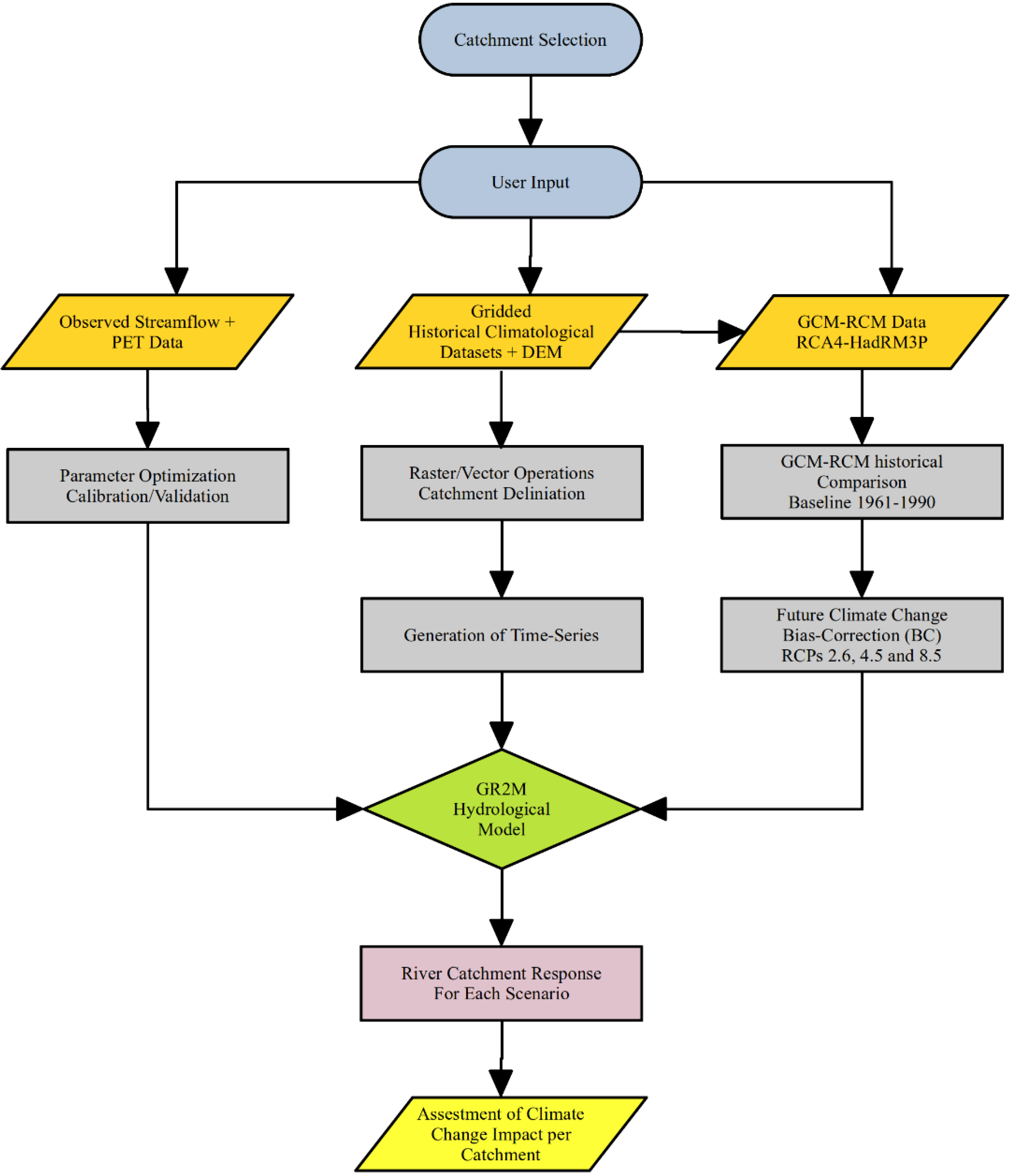


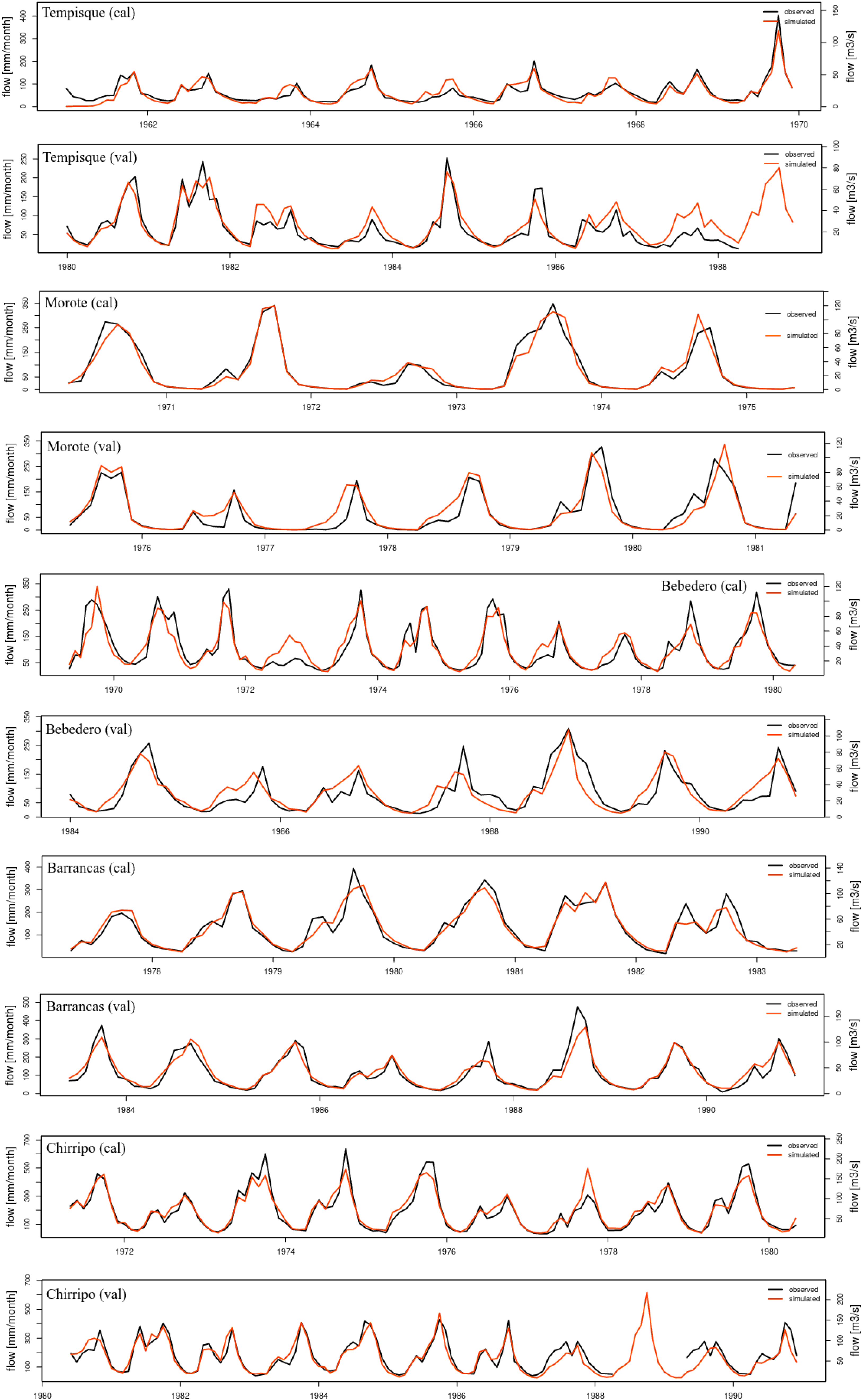
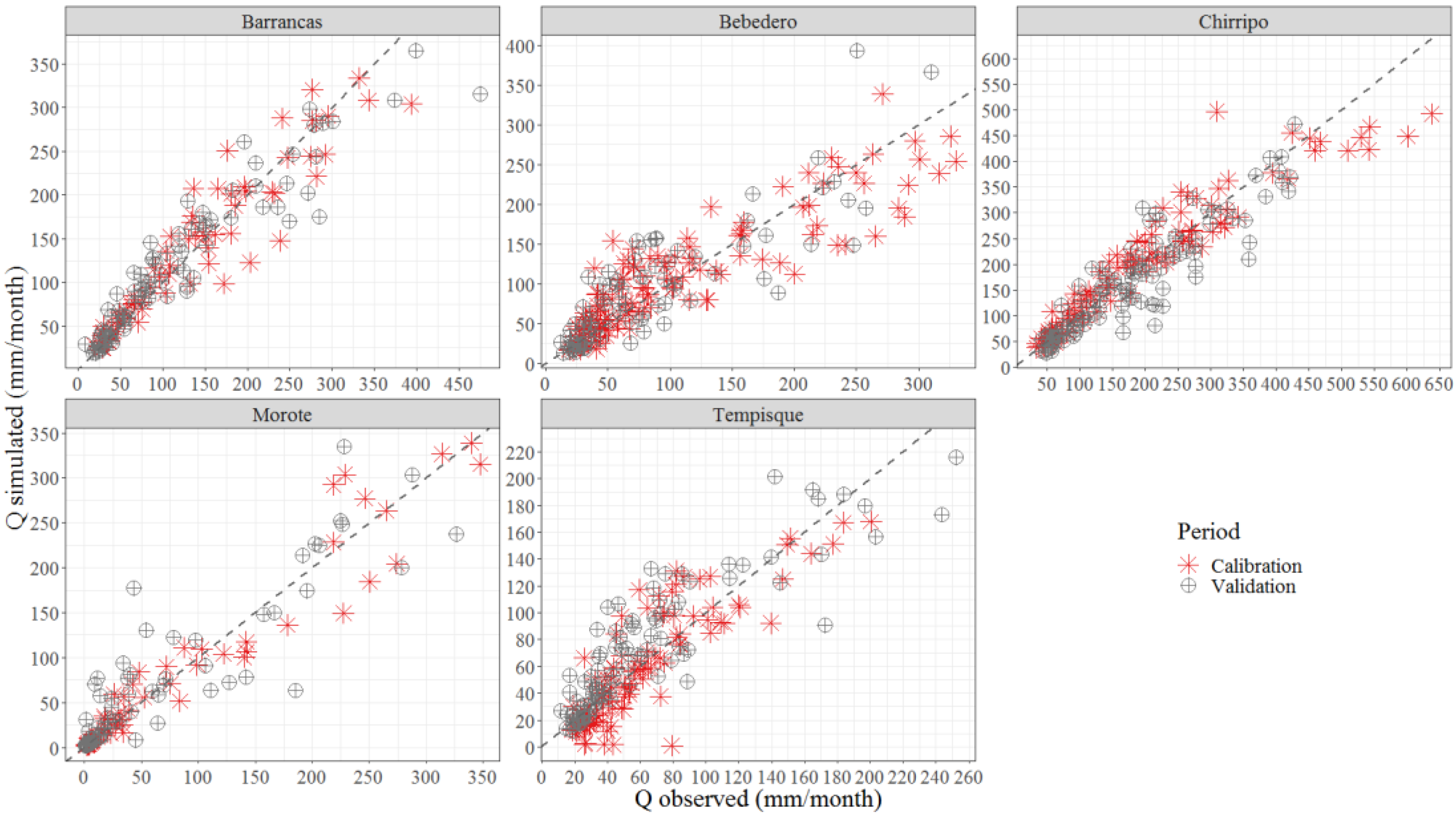
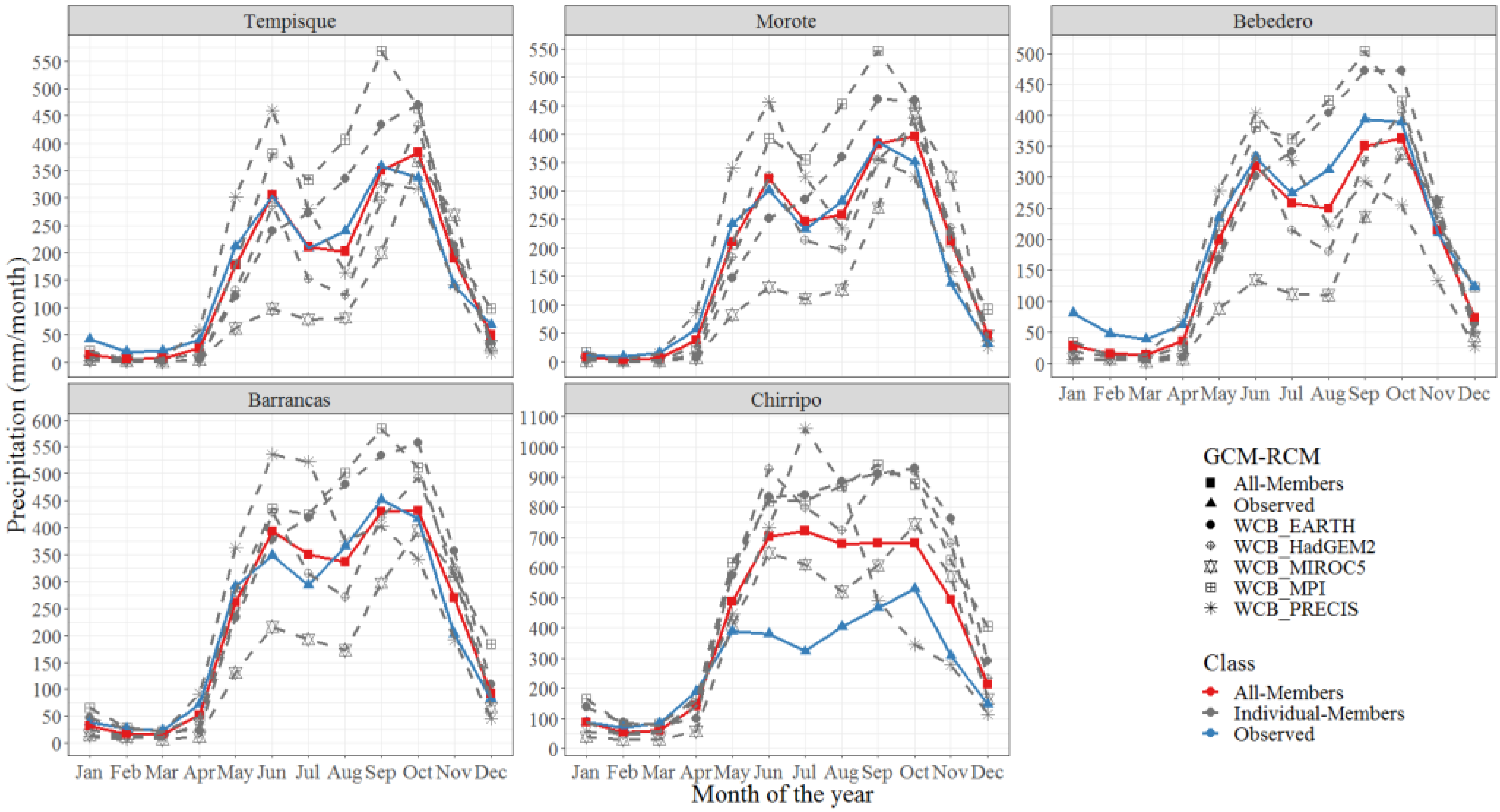
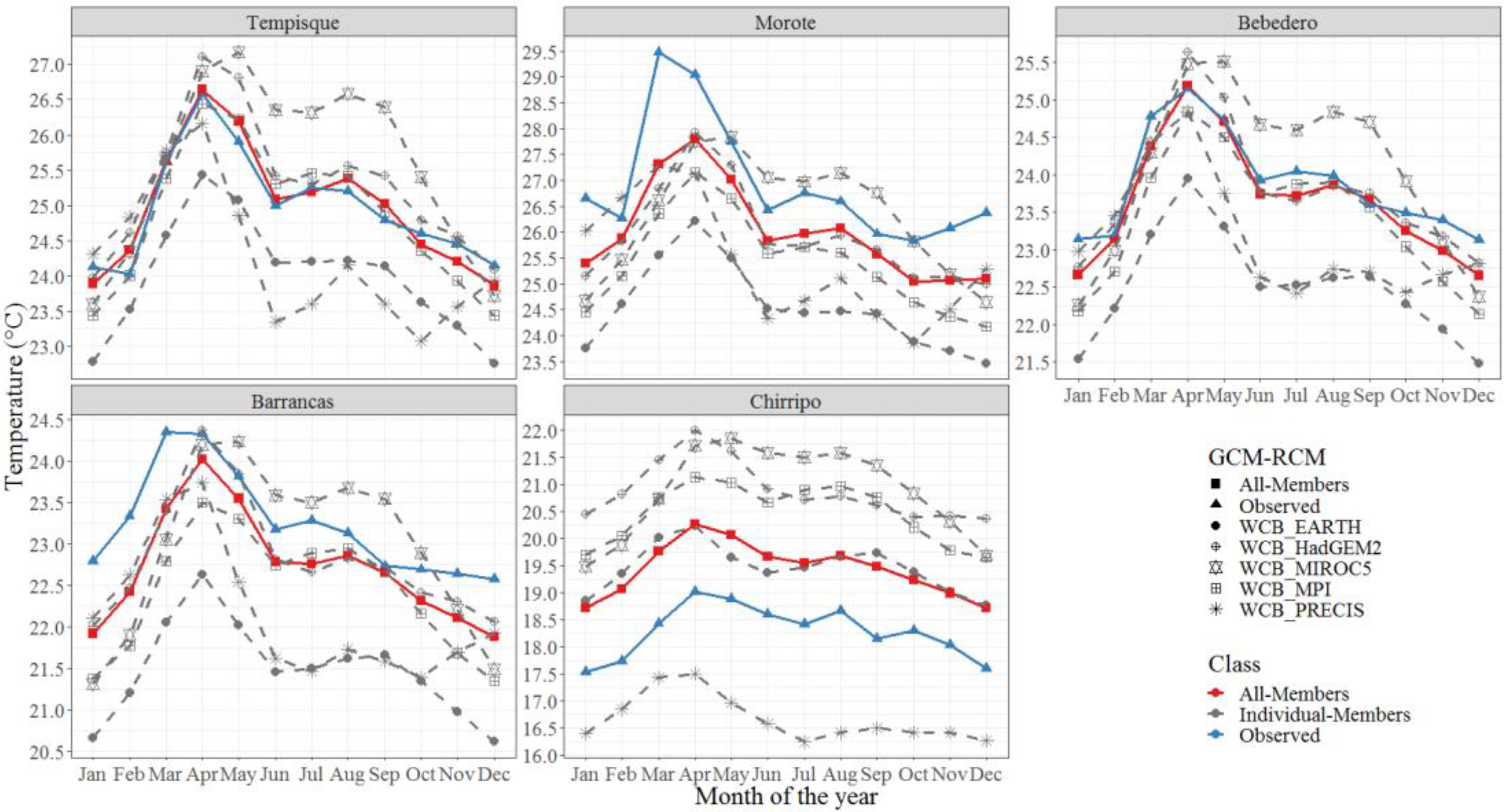

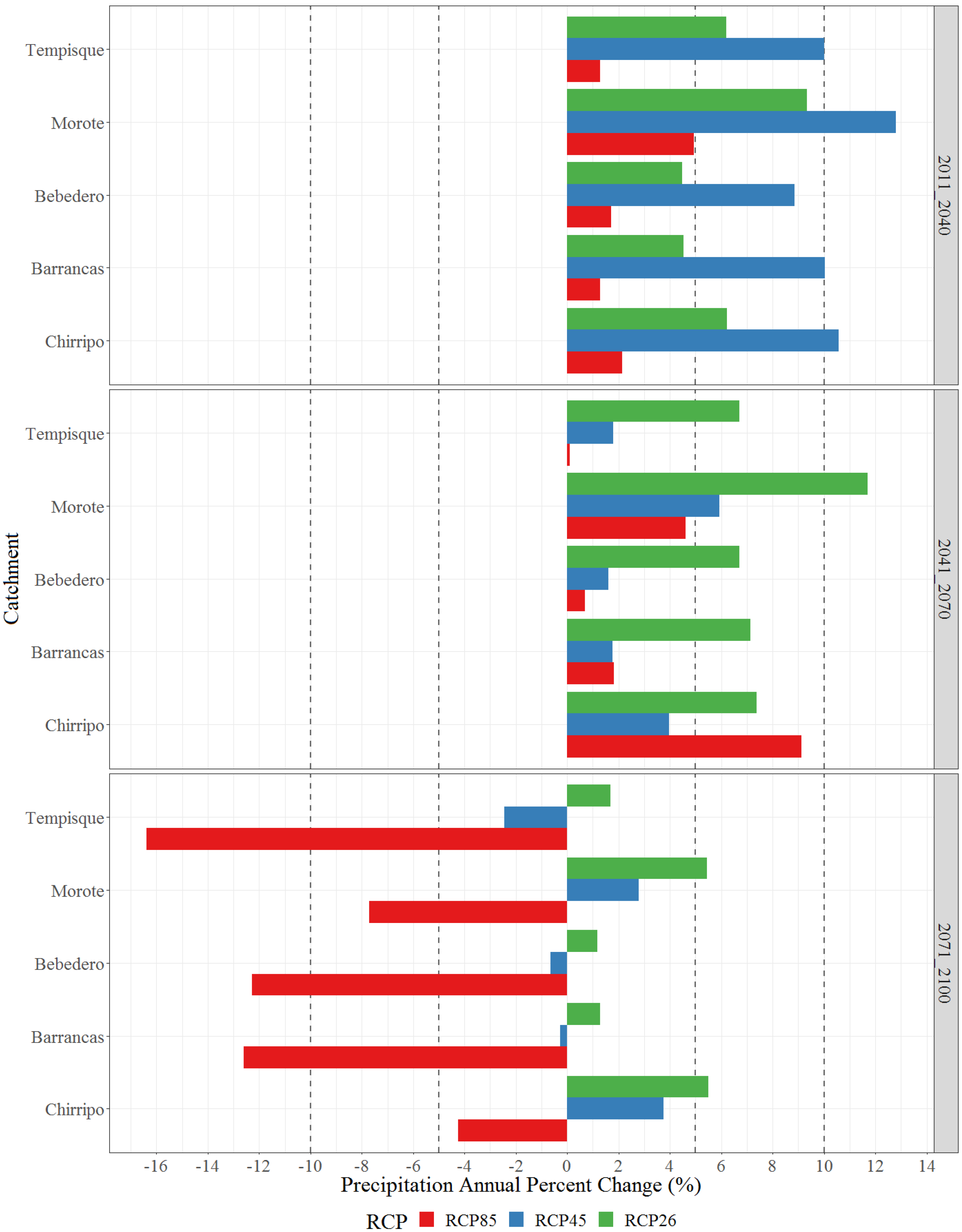
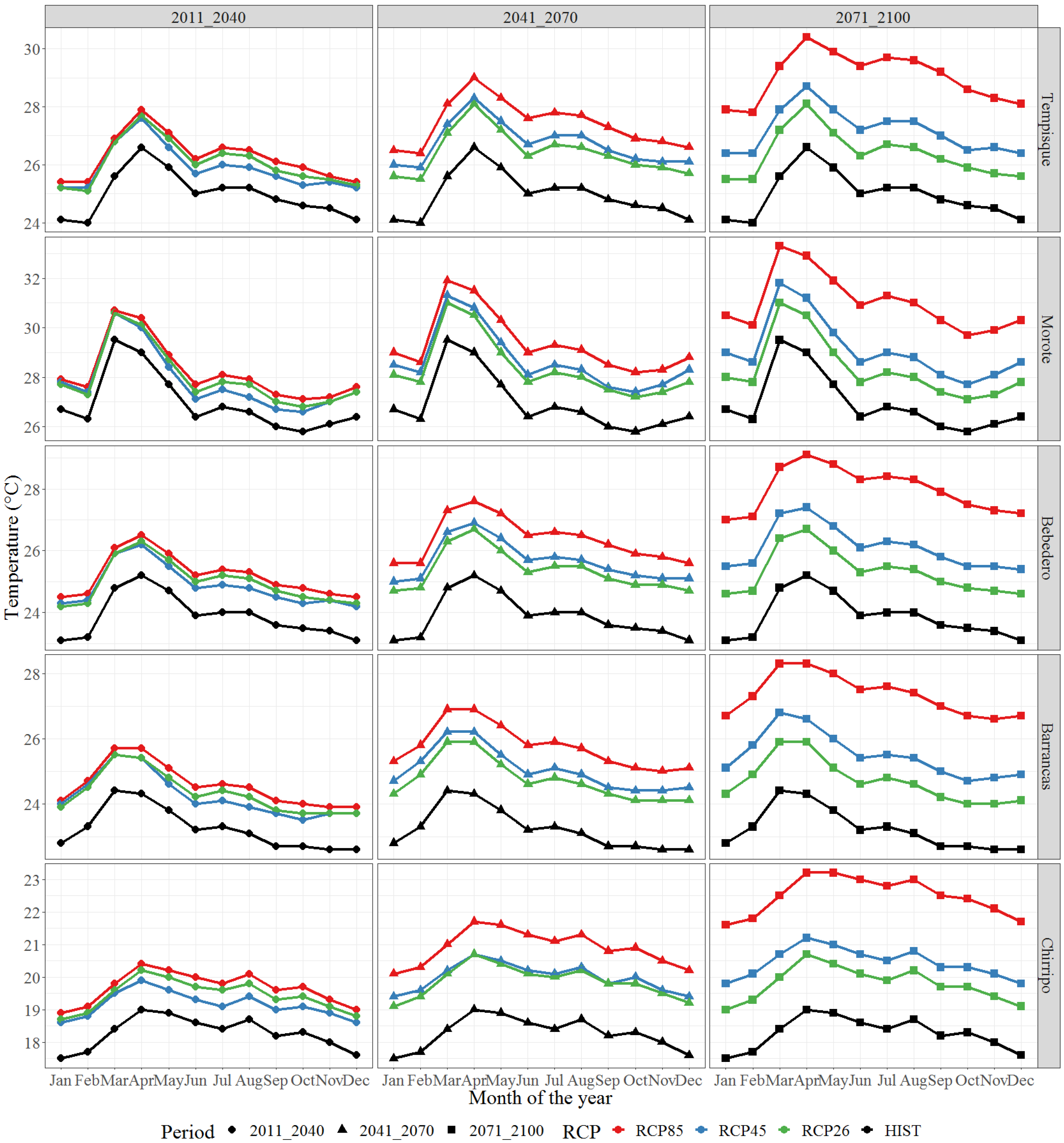
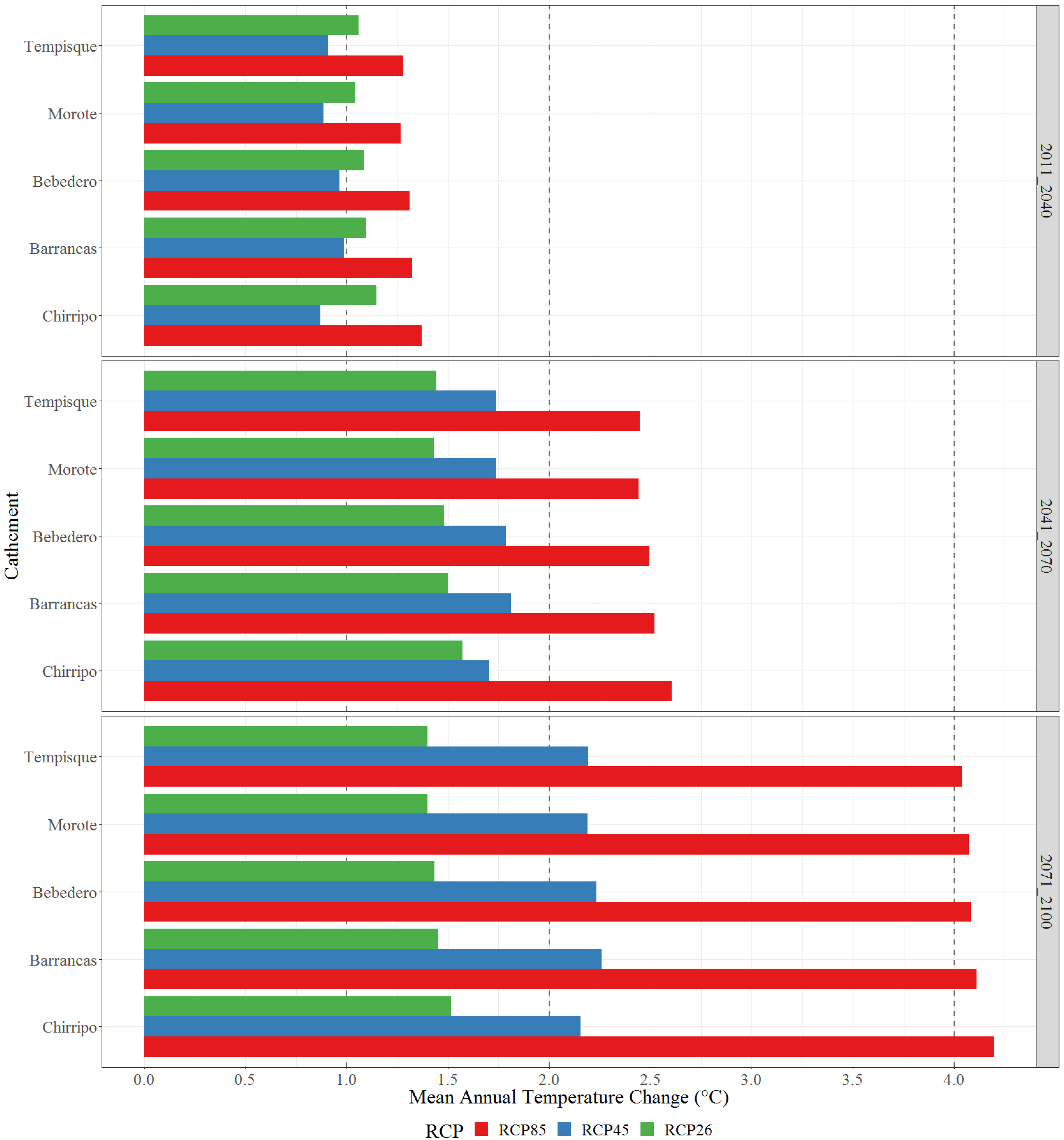

| Catch | A | P | Min Alt | Max Alt | S | P | T | PET | Cal | Val |
|---|---|---|---|---|---|---|---|---|---|---|
| Tempisque | 929 | 232 | 13 | 1906 | 30.47 | 1991 | 25.6 | 1090 | 1961–1969 | 1980–1988 |
| Morote | 269 | 106 | 16 | 848 | 28.86 | 2057 | 26.9 | 1098 | 1970–1975 | 1976–1981 |
| Bebedero | 130 | 61 | 192 | 1543 | 27.85 | 2502 | 23.9 | 1135 | 1969–1980 | 1984–1990 |
| Barrancas | 212 | 120 | 230 | 286 | 30.10 | 2614 | 23.2 | 1123 | 1977–1983 | 1984–1990 |
| Chirripó Pacífico | 322 | 81 | 790 | 3800 | 32.19 | 3376 | 18.2 | 1162 | 1971–1980 | 1980–1990 |
| Driving GCM-Model | Country | GCM Model-Center | RCM | RCM Model-Center | RCM Resolution | Source | RCP2.6 | RCP4.5 | RCP8.5 |
|---|---|---|---|---|---|---|---|---|---|
| HadGEM2-ES | UK | Met Office Hadley Centre | HadRM3P | Met Office Hadley Centre | 0.22° × 0.22° | ITCR | X | X | X |
| CanESM2 | Canada | Canadian Centre for Climate Modelling and Analysis | RCA4 | Swedish (SHMI) | 0.44° × 0.44° | CORDEX | O | O | X |
| EC-EARTH | Ireland | Irish Centre For High-End Computing | RCA4 | Swedish (SHMI) | 0.44° × 0.44° | CORDEX | X | X | X |
| HadGEM2-ES | UK | Met Office Hadley Centre | RCA4 | Swedish (SHMI) | 0.44° × 0.44° | CORDEX | X | X | X |
| MIROC5 | Japan | The University of Tokyo Center for Climate System Research | RCA4 | Swedish (SHMI) | 0.44° × 0.44° | CORDEX | X | O | X |
| MPI-ESM-LR | Germany | Max Planck Institute for Meteorology | RCA4 | Swedish (SHMI) | 0.44° × 0.44° | CORDEX | X | X | X |
| Optimization | Calibration | Validation | ||||||||
|---|---|---|---|---|---|---|---|---|---|---|
| Catchment | X1 | X2 | NSE | KGE | R | PBIAS | NSE | KGE | R | PBIAS |
| Tempisque | 2980.958 | 0.963 | 0.812 (very good) | 0.893 (very good) | 0.907 (very good) | −4.810 (very good) | 0.737 (good) | 0.801 (very good) | 0.881 (very good) | 15.180 (good) |
| Morote | 772.784 | 0.968 | 0.931 (very good) | 0.958 (very good) | 0.965 (very good) | −1.230 (very good) | 0.792 (very good) | 0.864 (very good) | 0.897 (very good) | 8.880 (very good) |
| Bebedero | 2298.472 | 0.888 | 0.811 (very good) | 0.825 (very good) | 0.902 (very good) | 1.680 (very good) | 0.710 (good) | 0.806 (very good) | 0.845 (very good) | 3.720 (very good) |
| Barrancas | 2951.297 | 0.993 | 0.894 (very good) | 0.913 (very good) | 0.946 (very good) | 0.630 (very good) | 0.882 (very good) | 0.842 (very good) | 0.944 (very good) | 1.790 (very good) |
| Chirripó Pacífico | 2368.471 | 0.968 | 0.899 (very good) | 0.876 (very good) | 0.951 (very good) | 2.480 (very good) | 0.816 (very good) | 0.885 (very good) | 0.912 | |
| July Mass-Balance-Change [%] | ||||
|---|---|---|---|---|
| RCP | 2011-2040 | 2041-2070 | 2071-2100 | Catchment |
| RCP26 | 8.4 | 2.2 | −5.6 | Tempisque |
| RCP45 | 15.6 | −10.8 | −23.7 | Tempisque |
| RCP85 | −9.1 | −23.2 | −59.8 | Tempisque |
| RCP26 | 25.1 | 19.2 | 4.3 | Morote |
| RCP45 | 38.0 | 5.9 | −10.3 | Morote |
| RCP85 | 5.9 | −12.9 | −56.4 | Morote |
| RCP26 | 7.5 | 9.6 | −2.5 | Bebedero |
| RCP45 | 21.1 | −2.8 | −8.2 | Bebedero |
| RCP85 | −0.9 | −13.5 | −44.6 | Bebedero |
| RCP26 | 10.4 | 15.4 | 1.0 | Barrancas |
| RCP45 | 29.2 | −4.1 | −10.7 | Barrancas |
| RCP85 | 1.5 | −8.7 | −46.6 | Barrancas |
| RCP26 | 17.5 | 27.6 | 19.9 | Chirripó Pacífico |
| RCP45 | 41.6 | −9.8 | −10.7 | Chirripó Pacífico |
| RCP85 | 4.8 | 15.1 | −45.2 | Chirripó Pacífico |
| October Mass-Balance-Change [%] | ||||
| RCP | 2011-2040 | 2041-2070 | 2071-2100 | Catchment |
| RCP26 | 10.9 | 9.5 | 4.7 | Tempisque |
| RCP45 | 21.9 | 13.5 | 8.3 | Tempisque |
| RCP85 | 3.2 | 3.8 | −21.1 | Tempisque |
| RCP26 | 15.9 | 14.1 | 13.3 | Morote |
| RCP45 | 19.8 | 27.4 | 27.0 | Morote |
| RCP85 | 12.0 | 18.4 | 21.8 | Morote |
| RCP26 | 9.6 | 8.6 | 5.0 | Bebedero |
| RCP45 | 18.7 | 16.6 | 17.8 | Bebedero |
| RCP85 | 5.9 | 11.3 | −0.2 | Bebedero |
| RCP26 | 10.1 | 8.1 | 5.1 | Barrancas |
| RCP45 | 20.5 | 14.8 | 13.6 | Barrancas |
| RCP85 | 5.1 | 11.4 | −3.8 | Barrancas |
| RCP26 | 15.6 | 9.0 | 13.3 | Chirripó Pacífico |
| RCP45 | 20.4 | 19.9 | 21.6 | Chirripó Pacífico |
| RCP85 | 10.9 | 23.9 | 23.1 | Chirripó Pacífico |
| Future Annual Mass-Balance-Change [%] | ||||
| RCP | 2011_2040 | 2041_2070 | 2071_2100 | Catchment |
| RCP26 | 10.2 | 8.6 | 1.1 | Tempisque |
| RCP45 | 17.8 | 2.3 | −6.3 | Tempisque |
| RCP85 | 0.6 | −2.5 | −32.6 | Tempisque |
| RCP26 | 17.7 | 18.8 | 8.8 | Morote |
| RCP45 | 24.6 | 14.2 | 7.4 | Morote |
| RCP85 | 9.0 | 8.7 | −12.0 | Morote |
| RCP26 | 7.8 | 9.6 | 2.2 | Bebedero |
| RCP45 | 15.6 | 7.1 | 5.0 | Bebedero |
| RCP85 | 3.5 | 3.8 | −13.3 | Bebedero |
| RCP26 | 9.3 | 12.2 | 3.9 | Barrancas |
| RCP45 | 18.5 | 6.5 | 3.0 | Barrancas |
| RCP85 | 4.2 | 5.8 | −16.7 | Barrancas |
| RCP26 | 14.4 | 15.7 | 13.1 | Chirripó Pacífico |
| RCP45 | 21.0 | 10.9 | 9.5 | Chirripó Pacífico |
| RCP85 | 8.2 | 19.2 | −3.2 | Chirripó Pacífico |
Publisher’s Note: MDPI stays neutral with regard to jurisdictional claims in published maps and institutional affiliations. |
© 2022 by the authors. Licensee MDPI, Basel, Switzerland. This article is an open access article distributed under the terms and conditions of the Creative Commons Attribution (CC BY) license (https://creativecommons.org/licenses/by/4.0/).
Share and Cite
Mendez, M.; Calvo-Valverde, L.-A.; Imbach, P.; Maathuis, B.; Hein-Grigg, D.; Hidalgo-Madriz, J.-A.; Alvarado-Gamboa, L.-F. Hydrological Response of Tropical Catchments to Climate Change as Modeled by the GR2M Model: A Case Study in Costa Rica. Sustainability 2022, 14, 16938. https://doi.org/10.3390/su142416938
Mendez M, Calvo-Valverde L-A, Imbach P, Maathuis B, Hein-Grigg D, Hidalgo-Madriz J-A, Alvarado-Gamboa L-F. Hydrological Response of Tropical Catchments to Climate Change as Modeled by the GR2M Model: A Case Study in Costa Rica. Sustainability. 2022; 14(24):16938. https://doi.org/10.3390/su142416938
Chicago/Turabian StyleMendez, Maikel, Luis-Alexander Calvo-Valverde, Pablo Imbach, Ben Maathuis, David Hein-Grigg, Jorge-Andrés Hidalgo-Madriz, and Luis-Fernando Alvarado-Gamboa. 2022. "Hydrological Response of Tropical Catchments to Climate Change as Modeled by the GR2M Model: A Case Study in Costa Rica" Sustainability 14, no. 24: 16938. https://doi.org/10.3390/su142416938
APA StyleMendez, M., Calvo-Valverde, L.-A., Imbach, P., Maathuis, B., Hein-Grigg, D., Hidalgo-Madriz, J.-A., & Alvarado-Gamboa, L.-F. (2022). Hydrological Response of Tropical Catchments to Climate Change as Modeled by the GR2M Model: A Case Study in Costa Rica. Sustainability, 14(24), 16938. https://doi.org/10.3390/su142416938






